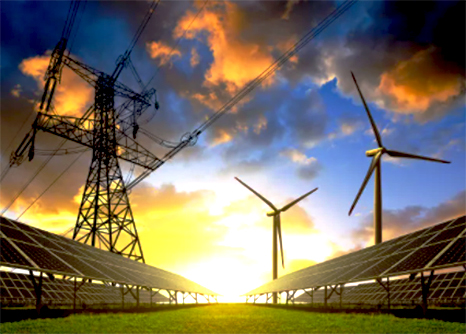The wind is a renewable energy source caused by uneven heating on the earth's surfaces by the sun. Wind power refers to converting the kinetic energy of wind into electricity. It is a kind of clean and pollution-free renewable energy, that has been used by people in the early times, mainly through windmills to pump water, grind surfaces, and so on. Using wind power to generate electricity is environmentally friendly, and the wind energy accumulation is huge.
Generators that capture wind energy
Horizontal axis wind turbine (HAWT)
The axis of rotation of a horizontal axis wind turbine is horizontal or parallel to the ground. It is usually equipped with two or three blades, which rotate around a horizontal axis driven by the wind. At normal wind speeds, horizontal-axis wind turbines generally produce more energy and are more efficient than vertical-axis systems. Depending on the system, they can produce 20% to 40% more power output than vertical-axis turbines.
Horizontal axis wind turbines are widely used in large wind farms, industrial and commercial uses, and individual homes due to their high efficiency and stability. In a wind farm, multiple horizontal-axis wind turbines are connected in parallel to form a large power generation system, which can efficiently provide a stable power supply to the grid.
Vertical axis wind turbine (VAWT)
The axis of rotation of a vertical axis wind turbine is perpendicular to the ground. Because its axis of rotation is perpendicular to the ground, the structure of a vertical-axis wind turbine is usually more compact. The overall shape is small. It is not restricted by wind direction and can capture energy from wind in all directions without relying on wind direction sensors or steering mechanisms to turn toward the wind.
For example, it can better adapt to complex urban environments or places with limited space; it can also maintain stable operation under high wind speeds and extreme wind speeds; it can also be used in some occasions with high requirements for aesthetics, such as scenic spots, parks, etc.

Detailed types of wind energy
Land-Based wind energy
Wind turbines can be used as stand-alone applications, or they can be connected to a utility power grid or even combined with a photovoltaic (solar cell) system. For utility-scale (megawatt-sized) sources of wind energy, a large number of wind turbines are usually built close together to form a wind plant, also referred to as a wind farm. Several electricity providers today use wind plants to supply power to their customers.
Stand-alone wind turbines are typically used for water pumping or communications. However, homeowners, farmers, and ranchers in windy areas can also use wind turbines as a way to cut their electric bills.
Distributed wind energy
Small wind systems also have potential as distributed energy resources. Distributed energy resources refer to a variety of small, modular power-generating technologies that can be combined to improve the operation of the electricity delivery system. Distributed wind energy systems are commonly installed on, but are not limited to, residential, agricultural, commercial, industrial, and community sites, and can range in size from a 5 kilowatt turbine at a home to a multi-megawatt (MW) turbine at a manufacturing facility. Distributed wind systems are connected on the customer side of the meter to meet the onsite load or directly to distribution or micro grids to support grid operations or offset large loads nearby. Distributed wind systems are defined by technology application, not technology size, and are typically smaller than 20 MW.
Offshore wind energy
Wind power is the fastest-growing green energy technology in the world. With the rapid development of land wind farm construction, people have noticed some limitations of land wind energy utilization, such as large areas, noise pollution, and other problems. Due to the abundance of offshore wind resources and the availability of today's technology, the ocean will become a rapidly growing wind market. Land wind generators are more optimized for noise reduction, and offshore is optimized to maximize aerodynamic efficiency. The high tip velocity and small blade area will bring some beneficial design changes to the fan structure and driveline system.
Hybrid wind energy
A hybrid wind energy system refers to the combination of wind energy with other energy forms (such as solar energy, hydropower, biomass energy, etc.) to form a more flexible, reliable, and efficient energy supply system. This system can overcome the limitations of a single energy source in terms of supply stability, seasonality, and regionality through the complementarity and synergy between different energy sources, thereby improving the reliability and economy of the entire energy system.
